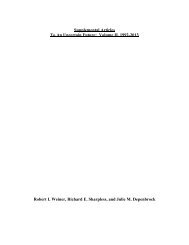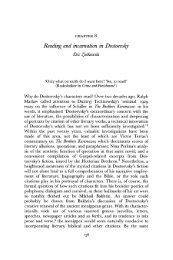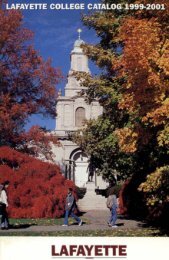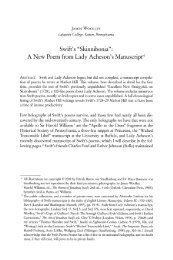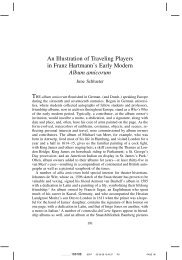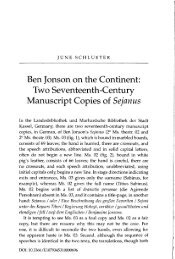Between Religion and Literature: Mircea Eliade ... - Lafayette College
Between Religion and Literature: Mircea Eliade ... - Lafayette College
Between Religion and Literature: Mircea Eliade ... - Lafayette College
You also want an ePaper? Increase the reach of your titles
YUMPU automatically turns print PDFs into web optimized ePapers that Google loves.
<strong>Eliade</strong> <strong>and</strong> Frye<br />
Frye, too, views myth <strong>and</strong> literature as directly akin <strong>and</strong> as fulfilling<br />
analogous social functions. Expressly fond of <strong>Eliade</strong>'s concept of myth as a<br />
means for nullifying the "terror of history" <strong>and</strong> returning to the world<br />
above or prior to ordinary time, in illo tempore, I3s Frye finds that literature<br />
fulfills its function as the imagination delivers text <strong>and</strong> readers from what<br />
he himself calls "the bondage of history." Like <strong>Eliade</strong>, he views myth as a<br />
certain kind of story of special seriousness <strong>and</strong> importance about a god or<br />
other divine being that is told to explain some particular feature of the<br />
society to which it belongs <strong>and</strong> that can be studied in regard to its content<br />
<strong>and</strong> form."14 In keeping with his view of myth as a form of imaginative<br />
thinking, he, like <strong>Eliade</strong>, regards literature as "a reconstructed mythology"<br />
or as mythology's "direct descendant."'5 Where Frye, as literary<br />
critic, differs from <strong>Eliade</strong> is in his lack of concern with the question of<br />
myth's existential value <strong>and</strong> in his insistence that "the real meaning of a<br />
myth is revealed, not by its origin, which we know nothing about, but by<br />
its later literary career, as it becomes recreated by the poets.""6<br />
The "literary career" of myths presents a crucial problem that <strong>Eliade</strong><br />
skirts in his discussions of literature's relation to myth: how, or by what<br />
process, does the mythological become, or leave its imprint on, or manifest<br />
itself within, literature? The crux of <strong>Eliade</strong>'s underst<strong>and</strong>ing of that<br />
relationship is his concept of the eventual survival, corruption, <strong>and</strong> camouflaging<br />
of myths; if, as quoted earlier, he could describe his research as<br />
an effort "to relocate the forgotten sources of literary inspiration," he<br />
regards literature as one of the major realms in which mythic <strong>and</strong> symbolic<br />
sources now lie hidden."' Notwithst<strong>and</strong>ing his admitted use of a<br />
"camouflaging" technique as a novelist <strong>and</strong> story writer,"8 however,<br />
<strong>Eliade</strong> as a scholar does not explore the formal process through which the<br />
camouflaging occurs.<br />
As a mode of literary analysis, Frye's myth criticism addresses precisely<br />
this problem. He observes that, just as individual myths collect to form a<br />
mythology or a coherent order of stories, so individual literary works collect<br />
to form literature as a whole. This leads to his insight into the<br />
twofold-functional <strong>and</strong> formal-transformation that takes place when<br />
113 <strong>Eliade</strong>'s notion is cited repeatedly by Northrop Frye; e.g., Fables of Identity (n. 35 above),<br />
p. 30, "<strong>Literature</strong> <strong>and</strong> Myth," in Thorpe, ed. (n. 35 above), p. 27, <strong>and</strong> The Great Code (n. 22<br />
above), pp. 48, 84.<br />
114 See Frye, "<strong>Literature</strong> <strong>and</strong> Myth," p. 27, "Myth, Fiction, <strong>and</strong> Displacement" in Fables oflden-<br />
tity, pp. 30-31.<br />
I" Frye, Fables of Identity, p. 38, Spiritus Mundi (n. 15 above), p. 72; cf. Educated Imagination<br />
(n. 41 above), pp. 57, 110.<br />
116 Frye, "<strong>Literature</strong> <strong>and</strong> Myth," p. 38.<br />
"17 For example, <strong>Eliade</strong>, Patterns (n. 1 above), pp. 431-34, Myth <strong>and</strong> Reality, pp. 187-93.<br />
118 <strong>Eliade</strong>,Journal II (n. 32 above), p. 120; Two Tales (n. 107 above), p. x; "Foreword," Tales of<br />
the Sacred (n. 78 above), p. 10.<br />
517



